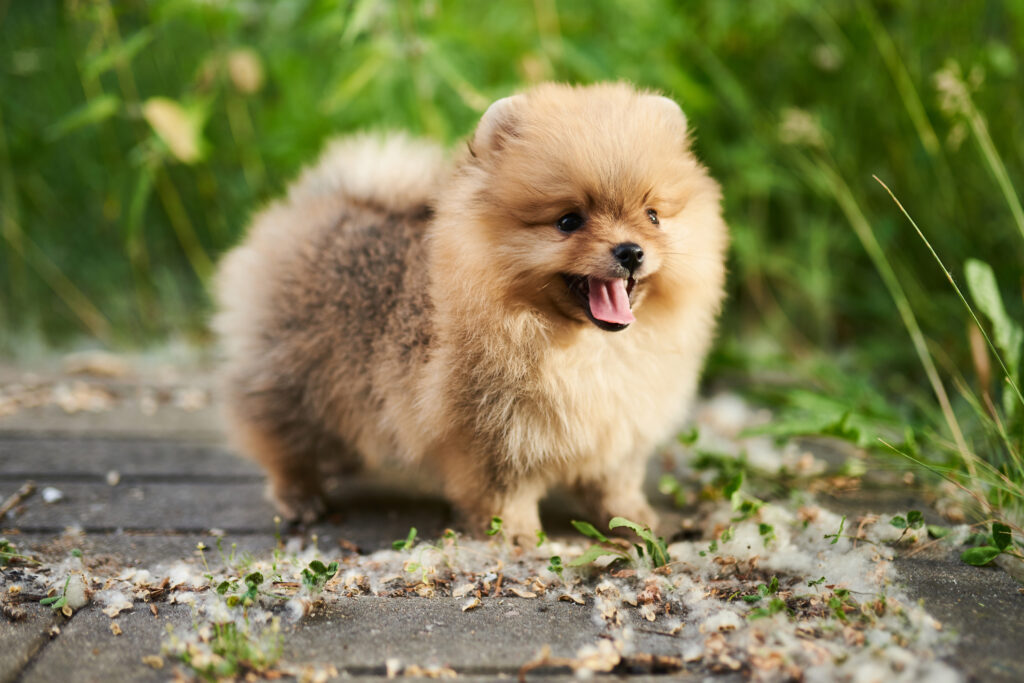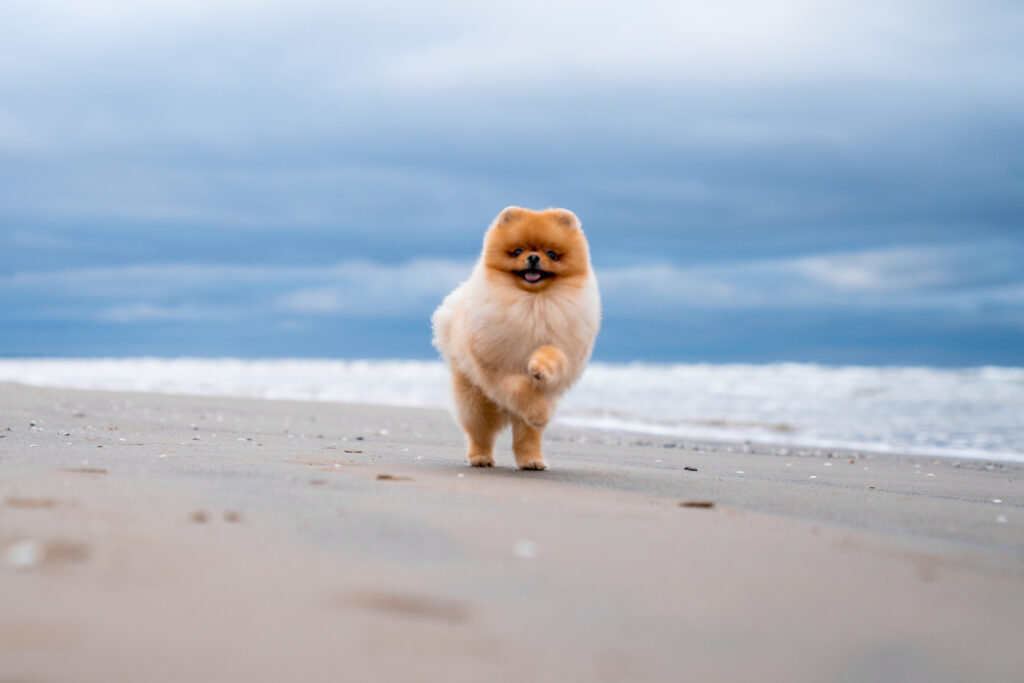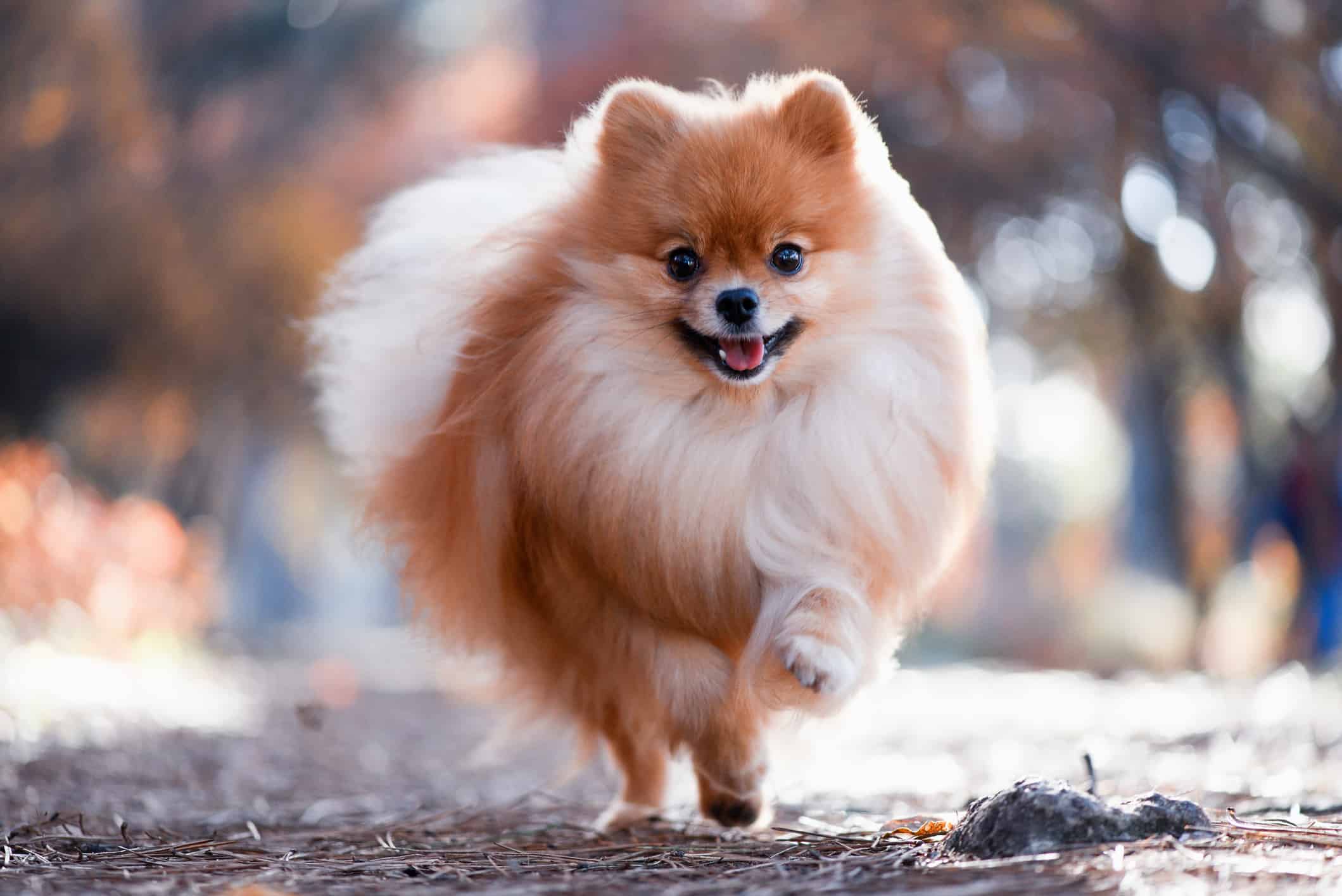The Pomeranian – popularly known as a Pom or Pom-Pom – is a small dog breed that is a descendant of the larger Spitz dog. The breed’s name is derived from the Pomerania region in north-east Germany and west Poland. Often referred to as Dwarf Spitz (Zwergspitz), Pomeranians are easily recognized by their small size, smiling face, and fluffy coat.
In this article, we will look at the characteristics of the Pomeranian, study the origins of this toy breed, and answer frequently asked questions.
Pomeranian breed characteristics
Pomeranians have one of the widest range of colors of any dog breed. The breed can be spotted in the color of black, black and tan, blue, brindle, brown, brown and tan, cream, orange, red, sable, spotted, white, or a mix of any of these colors.
The Pomeranian is a small breed that weighs between three and seven pounds. The female Pomeranians are between 7 and 12 inches tall, whilst males can reach 14 inches at their withers.
- The Pomeranian has a double coat. Their undercoat is short but dense, and forms the outer coat that stands off from the body and forms a ruff of fur on the neck. The coat is one of the most well-known traits of the breed.
- The breed has plenty of nicknames. It isn’t unusual to hear someone calling a Pomeranian a Pom-Pom, Pom Dog, Tumbleweed, or Pommy, to name a few.
- Pomeranians are very energetic, smart and bold dogs that are curious by nature. The breed is relatively easy to train, although potty training can be a little harder because of its size.
- Pomeranians are one of the healthiest dog breeds. Many Pomeranians will live long, fulfilled lives without major health problems, but they do suffer from common ailments like the luxating patella (dislocation of the kneecap) and tracheal collapse (blocked airflow to the lungs).

A brief history of the Pomeranian
Pomeranians are considered to be a descendant of Spitz type of dogs. The Spitz dogs were already around at the time, but the modern Pomeranians were influenced by the British Royal Family. In 1767, Queen Charlotte brought two Pomeranians to England. At the time, the breed was very similar to the Pomeranians we see today. The breed had a fluffy coat with a curled tail but weighed approximately ten times more than the modern Pomeranians, at around 35 to 50 pounds.
The biggest change to the breed happened during the lifetime of Queen Victoria, the granddaughter of Queen Charlotte. One of her favored dogs was a red sable Pomeranian who reportedly weighed just 12 pounds. This was very small for a Pomeranian at the time. The dog’s name was Marco, and after it was first exhibited in 1891, the breeders began only selecting the smaller Pomeranians.
Queen Victoria also continued to work on making the breed smaller by importing small Pomeranians from other countries. Pomeranians imported to England by Queen Victoria had different colors, which is one of the reasons why we have so many different colored Pomeranians to this day. Over Queen Victoria’s lifetime, the size of the Pomeranian had decreased by more than half.
The first Pomeranian was registered in the United States to the American Kennel Club in 1898, and in 1900, the AKC recognized the breed. In 1926, the first Pomeranian won the Westminster Kennel Club Dog Show. Although this was a huge success for the breed, it took the breed until 1988 to win its first Best in Show award.

Pomeranians today
Pomeranians are companion dogs and have fulfilled this role for more than two centuries. Pomeranians are lovely pets that are curious, energetic, and very playful. They are good family pets, but may not be a good choice for families with very active or young children because of their size.
They are very loyal and love their humans, but their affectionate nature also means that they can be clingy at times. Most Pomeranians suffer from separation anxiety. They are companion dogs and want to be with their humans at all times. Early training as a puppy will help to prevent separation anxiety if the dog accepts the absence of the owner.
Despite their size, Pomeranians are bold and brave dogs. They tend to think that they rule and can get away with anything. It is important to set rules and boundaries with a Pomeranian. This will prevent common behavioral problems like barking. Some Pomeranians can bark or do other unpleasant things to seek attention.
Even though they are a small breed, Pomeranians are very alert and active. They won’t hold back to let you know if anything odd is taking place nearby. If you live an active life and don’t have small children, a Pomeranian can be a great companion dog. They love attention – and if you have enough of it to give a Pomeranian, it can be the perfect pet to have around!

Frequently Asked Pomeranian Questions
What is the lifespan of a Pomeranian?
A healthy dog breed, the average lifespan of Pomeranians is between 12 and 16 years. Regular visits to the veterinarian, a healthy diet and weight, and daily exercises will help a Pomeranian live longer.
How do you groom a Pomeranian?
Like virtually all dogs, Pomeranians require regular grooming. Their coat should be brushed at least three times a week but brushing daily is highly recommended. When trimming the coat of a Pomeranian, take extra care – the coat will not grow the way it should if it is shaved deeply. If you’re not comfortable with using clippers, use good quality scissors to trim your Pomeranian. Remove excess fur from around the hindquarters, paws, eyes, and shape the dog in areas to maintain the famous fluffy look.
All of the above may seem like hard work, or perhaps you aren’t comfortable with grooming a Pom yourself. If you’re unsure, visiting a professional dog groomer is highly recommended.
How do you bathe a Pomeranian?
Regular bathing is very good for the skin and coat of Pomeranians. Start by brushing the fur to prep the skin and remove the dead shedding hair for the bath. A hypoallergenic pet shampoo is perfect for bathing a Pomeranian. Use warm water to shampoo the dog before rinsing. Preferably, shampoo your dog twice. After shampooing, you can apply a hair conditioner and leave it for a few minutes. Then rinse with warm water to remove the remnants of the conditioner and dry thoroughly with a towel.
How do you make a Pomeranian's hair grow back?
The undercoat of a Pomeranian should never be cut. The fur can grow back after the undercoat is cut, but it will not grow the way it normally would. The hair will grow in odd patches with a wiry texture. This will make the Pomeranian lose its well-known, distinctive fur. The hair of a Pomeranian can grow faster by shampooing the fur once a week – shampoo your Pomeranian to encourage healthy hair growth. Gently massage the fur with dog hair conditioner and rinse off with warm water to remove any conditioner residue. Along with shampooing, daily brushing can help a Pomeranian grow its hair back faster.
How many puppies can a Pomeranian have?
In a litter, Pomeranians can have between 1 to 5 pups. The normal gestation period is about 63 days, but between 55 and 70 days is considered normal.
How much food does a Pomeranian need?
Pomeranians rely on very little food. The recommended daily amount of food for an adult Pomeranian is about 1/3 to 1/2 cup of dry food, which should be given two times a day. Pomeranian puppies need more calories than adults. A puppy needs at least 1/2 cup of dry food that should be given in 3-4 meals.
Read more in this series:
- About The Breed: Australian Shepherd
- About The Breed: Basset Hound
- About The Breed: Beagle
- About The Breed: Bloodhound
- About The Breed: Bulldog
- About The Breed: Chihuahua
- About The Breed: Dachshund
- About The Breed: French Bulldog
- About The Breed: German Shepherd
- About The Breed: Greyhound
- About The Breed: Golden Retriever
- About The Breed: Labrador Retriever
- About The Breed: Pembroke Welsh Corgi
- About The Breed: Pug
- About The Breed: Siberian Husky
- About The Breed: Yorkshire Terrier


You must be logged in to post a comment.